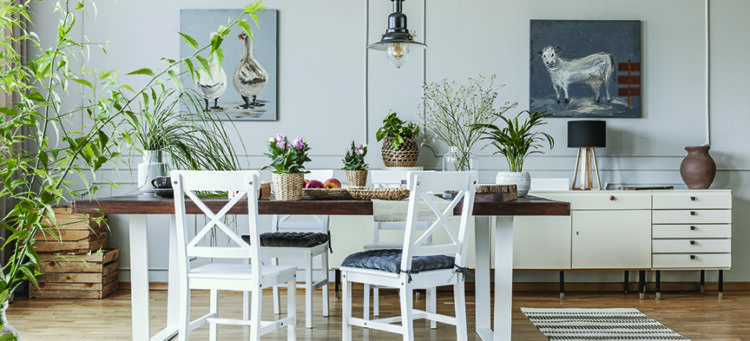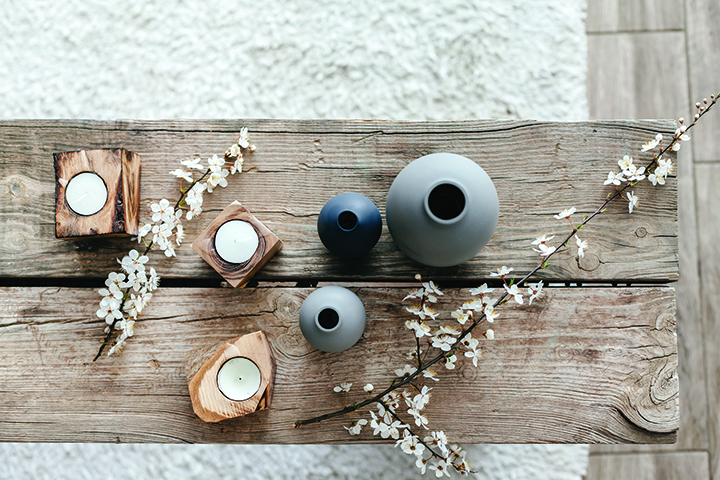
The 8s
Top interior design trends worth following
March, 2021
If 2020 proved anything, it was that your home was literally your castle. Your pad doubled as both a living space and fortress buffering your family from the effects of infection via COVID-19. While we’re still hunkering down, interior design experts have suggested that 2021 is the year we shed our bunker mentality and make our dwellings more engaging and inviting.
1. Cottagecore
Blame the quarantine for this buzzword, coined by social media influencer and designer Paula Sutton, which hints at a huge craving for comfort that only a summer getaway cottage could provide. For those unable to get to their retreats and others who don’t own a cabin, the next best thing is to add a cozy element to your confines, with colours reflecting your natural surroundings, wooden furniture, floral decorations and lots of wicker.
2. Natural Materials
While this trend has long been an offshoot of environmentalism’s impact on culture, it’s getting a lot more traction of late. The focus here is an overall rejection of synthetic materials from polyester fabrics to plastic composites used in making furniture and even parts of your home. So look at linens and cotton for curtains, marble tops for bathrooms, and wood or even metal for furniture.
3. Grandmillennial
Following up on the “granny chic” trend that recently brought back frilly, floral-print dresses, this trend, long predicted by designer Heather Goerzen, is totally steeped in nostalgia. This style is totally geared towards rekindling fond memories of your grandparents’ abode with a focus on wallpaper, vintage furniture, antique household items, crocheted covers and doilies and even china dishware.
4. Global Getaway
The lockdown has prevented hardy travelers from taking off to sunnier or more exotic climes, which is why several design pundits suggest redesigning your home to reflect the vibe of your favorite getaway spot. Tropical plants and floral wallpaper is highly recommended to emulate that forbidden destination, while bright tones can act as stress-relievers until that dastardly lockdown is finally lifted.
5. Going Minimal
With a lot more people who still have jobs now working at home, balancing your job and your family life is likely becoming more of a circus act. What isn’t helping is all that clutter now that paperwork is starting to dominate all those piles of stuff mounting every day, which is why going minimal is seen as a move that’s not only more pragmatic but easier on the eyes. Start with desks that both look good in a makeshift office as well as the living room and vintage furniture designed for storage.
6. More Home Entertainment
Traditionally, we used to have designated spaces for the TV, computer and the sound system. But being homebound has changed all that. Going out for a night on the town has given way to Netflix and chill (not to mention an emergence of more streaming opportunities), retrieving your favorite music online, more resolution in high-definition flatscreens, and more elaborate audio systems. In tandem with that demand will be furniture designed to take in all that entertainment, which might entice people to continue staying at home, once the all-clear signal has been given.
7. Classic Traditionalism
This is hardly a trend in that it’s never gone away, but it’s still noteworthy in that enough households are so taken by the allure of 19th-century interior design which boasts a charm all its own. This take on ye-olde Brit luxury is irresistible, especially to fans of such television fare as Downton Abbey, Poldark and Bridgerton.
8. Rustic Vogue
Taking into account all the aspects of previously-mentioned trends, rustic vogue isn’t a reflection of the “slob chic” that characterized the wardrobe of folks quarantined at home 24-7. Rather, it’s more of a slant towards character and uniqueness, combining modern with traditional. Emphasis is on having furniture that doesn’t match and having items made out of such materials as reclaimed wood that highlight the flaws of the components used. The first rule? Avoid having your home look like what’s on display at a big box store! t8n














